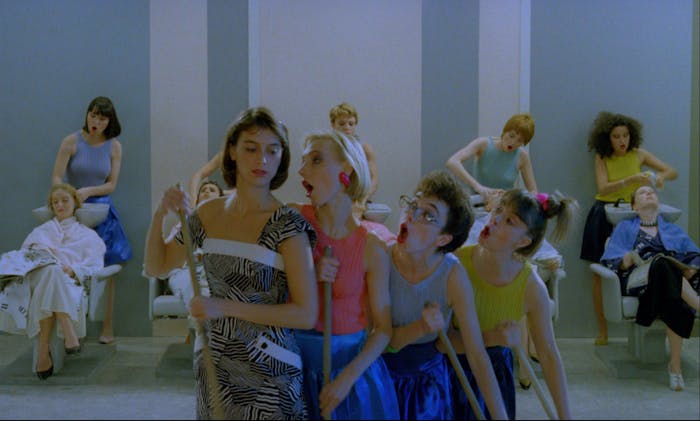Responding to a recent Sight & Sound poll declaring Chantal Akerman’s Jeanne Dielman to be ‘the greatest film of all time’ — and to news of a major retrospective of Akerman’s work to be held in Bozar in 2024 — Tessel Veneboer asks whether the flood of critical attention risks obscuring the full range of the filmmaker’s interests.
On a hot July day, I make my way through a crowd of pink dresses in the foyer of a Brussels movie theatre to watch a documentary about the feminist activism of the French actress Delphine Seyrig. As the door of the screening room closes on an audience of six and the murmur of the Barbie party fades, a man in the chair next to me points to a film still of Seyrig peeling potatoes. He turns to his date and asks her if she has seen Jeanne Dielman. When she says she hasn’t, he tells her that Akerman’s 1975 film is ‘the best movie ever made’ but warns her that it’s a ‘very intellectual’ movie.
A recent Sight & Sound poll (issued by the British Film Institute) has indeed declared Jeanne Dielman to be ‘the greatest film of all time’ — following in the footsteps of Orson Welles’ Citizen Kane (‘the greatest’ for forty years) and Alfred Hitchock’s Vertigo (which managed to hold the spot for only a decade). Leaving aside the question of what the Sight & Sound poll is actually trying to determine (cinematic innovation? a historically significant moment?), for some viewers and critics, the outcome of the poll is evidence of an elitist and academic pool of film critics. Only highly educated filmgoers would appreciate the modernist difficulty of a three-and-a-half-hour, hyperrealist depiction of housework as groundbreaking cinema. The Flemish director Jan Verheyen dismissed the survey as nonsense, because the film was clearly not intended for a large audience and dismissed Akerman’s entire oeuvre as ‘quatsch’. But to single out Jeanne Dielman as the centrepiece of Akerman’s oeuvre — as both Akerman enthusiasts and critics tend to do after the survey — risks overlooking the director’s interest in commercial genre films and the humour of much of her work. The attention to daily gestures in her films does more than politicise those gestures by elevating marginalised, daily lives through the authority of the silver screen. In her comedies and musicals, Akerman also explores the formulaic nature of sexual relations — often in bizarre and funny ways.
In Un Divan à New York (1996), for example, Akerman created a stereotypical American romcom full of clichés while sticking to her recurring theme of the stifling household. In the musical Golden Eighties (1986), Akerman shifts a heteronormative scenario à la West Side Story to a Brussels shopping mall where the girls and boys sing their hearts out. An existentialist teenager skips school and dances to ‘La Bamba’ with her unrequited crush in Portrait d’une jeune fille de la fin des années 60 à Bruxelles (1994). Akerman called Jeanne Dielman a love letter to her mother. She insisted that her entire oeuvre is an attempt to respond to the silence of her mother, who refused to talk about the time she spent in Auschwitz. Akerman’s comedies and musicals are themselves an important part of this reflection on her mother’s insistence: ‘There is nothing to say.’ In the films, misunderstandings, mispronunciations and slips of the tongue all point to the limits of language and revolve around her mother’s silence. But laughing, dancing and singing also reflect the ‘nothingness’ at the centre of her work.
With the ongoing expansion of genres such as autofiction and autotheory, lived experience and authenticity have become valuable objects of exchange. In the reappraisal of Jeanne Dielman, too, the ‘realness’ and material conditions of housework are often seen as the film’s most radical features. Although Akerman herself claimed that she made this film ‘to give life on film to all these typically undervalued actions’, Akerman’s politicisation of domesticity is not merely a matter of representation. The hyperrealistic depiction of everyday gestures — most famously, the peeling of a sack of potatoes in real time — does not directly express experience. Akerman’s interest in repetition and routine is a formalist concern. And to reduce the question of ‘women in cinema’ to one of representation and experience is to propose a ‘serious’ feminism that is strictly materialist and pedagogical. While this is undoubtedly important, it is certainly not the only strategy that Akerman’s work offers. When Jeanne Dielman premiered at the 1975 Cannes Festival, the French writer-director Marguerite Duras shouted at the screen, ‘This woman is crazy!’ and many of her fellow audience members walked out. Akerman’s supposed ‘intellectualisation’ of cinema still divides critics and audiences, but, given the breadth of Akerman’s work and her interest in genre films, it is clear that pleasure is just as crucial to Akerman’s formalist treatment of representation, affirmation and emancipation.
So, when the woman in the Brussels movie theatre tells her date that intellectual cinema is ‘not really her thing,’ it doesn’t necessarily pose a problem for the feminist politics of Akerman’s filmmaking. The bigger question is whether he will further acquaint himself with Akerman, beyond ‘the greatest movie of all time’.


